“Jacques Brel s’en va aux Marquises” . It was one of the lines printed on a t shirt I received from my father for my 14th birthday. It was one of those shirts with a number of main events that happened in the year of one’s birth. Freely translated it means something like “Jacques Brel is leaving us at the Marquises”. In 1978 the famous Belgian singer died and was buried on the Marquesas islands. At the time I didn’t like that present at all mainly because it was in French and thanks to a not so great French teacher, I really hated that language. But a little older and a little wiser, a couple of years later I found back the shirt and got intrigued about this place where our national icon Brel spent his last years. I looked up what these Marquesas were like and it seemed like an interesting place. Something to visit some day…
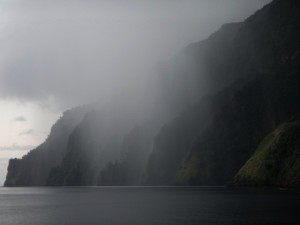 The Marquesas were probably the first islands to be colonized by the Polynesians in the great South Pacific ocean. It was from here that tribes that were defeated in tribal warfare ventured out the three corners of the ‘Polynesian triangle’: New Zealand, Hawai and Easter Island. It is the heart of historic Polynesia. It was also one of the last places to be colonized and Christianised because the people were considered to be so ferocious. The nature looks just as wild as the people were considered. No calm blue lagoons here. Instead you get an ocean pounding against towering cliffs, mountains and bays covered in lush green forests with sharp basalt pinnacles sticking out.
The Marquesas were probably the first islands to be colonized by the Polynesians in the great South Pacific ocean. It was from here that tribes that were defeated in tribal warfare ventured out the three corners of the ‘Polynesian triangle’: New Zealand, Hawai and Easter Island. It is the heart of historic Polynesia. It was also one of the last places to be colonized and Christianised because the people were considered to be so ferocious. The nature looks just as wild as the people were considered. No calm blue lagoons here. Instead you get an ocean pounding against towering cliffs, mountains and bays covered in lush green forests with sharp basalt pinnacles sticking out.
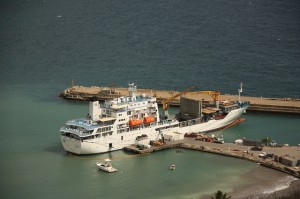 When you are looking for a place far from everything and everywhere, the Marquesas are your thing. The only way to get there is on your own sailing boat or on a plane or boat from Tahiti. We opted for the second option. Since the early 1980’s, every three weeks a cargo ship, the Aranui, sails to the Marquesas to supply these remote Islands. Over the years the ship has started to take more and more passengers also. These days its main function is still cargo but while the cargo is being loaded and unloaded passengers can go on shore. A number of hikes and excursions are possible at each stop but always subject to the requirements of the cargo operations. In France this trip has gotten a bit of a cult status but in most other countries it is fairly unknown. I found out about it through the classic South Pacific travel book of Paul Theroux. Basically if you want to see a couple of these islands and you don’t have a lot of money and a lot of time, the Aranui is your best option. It is not cheap but if like us you can live with sleeping in a dorm with 7 other people, it is definitely cheaper than flying around the islands and trying to organise the trips independently. The best option of course is to sail your own boat around the islands. But for us that was (for now) not really a feasible option.
When you are looking for a place far from everything and everywhere, the Marquesas are your thing. The only way to get there is on your own sailing boat or on a plane or boat from Tahiti. We opted for the second option. Since the early 1980’s, every three weeks a cargo ship, the Aranui, sails to the Marquesas to supply these remote Islands. Over the years the ship has started to take more and more passengers also. These days its main function is still cargo but while the cargo is being loaded and unloaded passengers can go on shore. A number of hikes and excursions are possible at each stop but always subject to the requirements of the cargo operations. In France this trip has gotten a bit of a cult status but in most other countries it is fairly unknown. I found out about it through the classic South Pacific travel book of Paul Theroux. Basically if you want to see a couple of these islands and you don’t have a lot of money and a lot of time, the Aranui is your best option. It is not cheap but if like us you can live with sleeping in a dorm with 7 other people, it is definitely cheaper than flying around the islands and trying to organise the trips independently. The best option of course is to sail your own boat around the islands. But for us that was (for now) not really a feasible option.
In the end it was a good choice. Of course, as we are not used to be travelling around in a large group and being tied to a rather strict schedule, it took a bit of adopting. We had some trouble with the ‘tour group mentality’ of some of the passengers. All the classics of ‘all inclusive/cruise tourism’ were present the first days: occupation of chairs on the deck with towels, the rush to the buffet, fighting for a spot to take a picture, people wanting to attract attention during info sessions only to prove their own stupidity,… But somehow after a couple of days it all mellowed out …or maybe we just couldn’t be bothered anymore. With our 35 years we were a bit of an odd case on board between the mostly retired (or nearly) passengers and some people gave us some awkward looks. One old French woman actually made it very clear that she did not like us ‘youngsters’ and let Caro understand that she shouldn’t think about stealing her camera because she was watching us… However these were more the exceptions, because most people on board were really cool and really experienced travellers. Actually I’m 100 % sure I have never seen so much travel experience together in one room. The number of people we talked to that had done one or more round the world trips could not be counted on our four hands. Many of them having travelled for really long periods of time. You thought our 8 month trip was long, what do you think about 4 years or 8 years or even 12 years of non-stop travel. Of course the cruise was a great way to see many islands in a short time and get to know and experience the Marquesan island life but the most valuable thing for us was the contacts with these ‘real world travellers’ and the inspiration they gave us for our own travel future.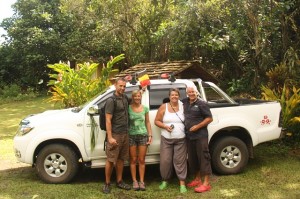 Two people in particular inspired us greatly: our compatriots Rene and Fabienne. The amazing stories of their travels made us feel very humble. Some of their most fabulous travel exploits included North and South America (down and up from the US to Ushuaia) by campervan, another campervan trip from Belgium to Nepal where they sold the van and continued backpacking to Japan, two ‘round the world’ sailing trips of 4 and 8 years… And all this with three young children!!! Their youngest son, now in his early twenties has actually lived more on a boat than on land. When we inquired about the practicalities and issues of travel with children for such a long time (cf. school, etc.), Rene answered that there is a solution for every issue. It’s been done by several people before and it is just a question of preparation, organisation and priorities (i.e. the ‘will to travel’). Or as he put it: “People who bury their travel plans because of children, are just looking for an excuse not to travel”.
Two people in particular inspired us greatly: our compatriots Rene and Fabienne. The amazing stories of their travels made us feel very humble. Some of their most fabulous travel exploits included North and South America (down and up from the US to Ushuaia) by campervan, another campervan trip from Belgium to Nepal where they sold the van and continued backpacking to Japan, two ‘round the world’ sailing trips of 4 and 8 years… And all this with three young children!!! Their youngest son, now in his early twenties has actually lived more on a boat than on land. When we inquired about the practicalities and issues of travel with children for such a long time (cf. school, etc.), Rene answered that there is a solution for every issue. It’s been done by several people before and it is just a question of preparation, organisation and priorities (i.e. the ‘will to travel’). Or as he put it: “People who bury their travel plans because of children, are just looking for an excuse not to travel”.
But back to our trip to the Marquesas. After a brief stop on the island of Fakarava in the Tuamotu islands group and 2 days of sailing we arrived on the most important island of the Marquesas; Nuku Hiva. Here we would be crossing the island by ‘4 wheel drives’ (4WD) from the Marquesan capital of Taiohae where the ship was being unloaded to Hatiheu, visiting a first archaeological site on the way. We also did a first hike to the picturesque bay of Anaho. In the evening we were picked up by the ship in the bay of the Taipivai valley. For people familiar with the works of Herman Melville (author of Moby Dick), this is the valley where he wrote his semi fiction book ‘Typee’. In this book he recounts the time he spent with the ‘cannibals of Typee’ after he jumped ship from a whaling ship. As said earlier the Marquesas had a really bad reputation among early seafarers for their blood thirst and cannibalism. One very ironical true story exists about survivors of a ship wreck near the Marquesas who were so afraid of these cannibals that instead of sailing 200 miles with the wind to these islands, decided to sail 2000 miles against the wind to Chile. The few people who made it, only did so by eating their fellow passengers… Now we have quite a bit of information to put these stories into perspective. Cannibalism has definitely existed on these islands. However it was practiced in very exceptional circumstances. During very rare ceremonies, warriors from enemy valleys/tribes were captured and killed. A small part of the person was eaten by high placed persons in the tribe to take up the ‘mana’ (a mythical force) of the person that was killed. Human flesh was however never used to feed people. In his book ‘Typee’, Melville gives a great description of the way these people and culture were organised in a very peaceful and idyllic way. One of the few accounts of this culture before it was completely destroyed by the Christian missionaries.
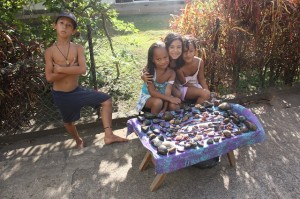 Our next stop was the island of Ua Poa. On this island I found out how small these communities are and how easily they welcome foreigners. As soon as the boat had docked in the morning, I got off the ship for a run. On the way I was greeted by all the locals that were up already. In the afternoon we sailed to another bay at the other side of the island and one of the persons selling fruit and vegetable at the local market came to me and said he ‘knew’ me. We had met that morning during my run and he immediately recognized me and came up for a chat and offered me some of his fruit. On Ua Poa we also found out a great deal about how the islands work and the role the Aranui ship plays. In fact food wise the Marquesas are almost fully self-sustainable. The climate and soil make it possible to provide all the food that is needed to survive. Still every 3 weeks the Aranui arrives with a huge cargo of food. It concerns of course a number of basic ingredients such as milk, sugar, etc. However a great part of it is ‘supplementary’ food (or ‘junk’ food as our guide called it); coca cola, beef, burgers, etc. Other items that are very often brought over by the Aranui, are cars and not small cars but huge 4WD pick-up trucks. Literally every family has at least one such a truck. If you wonder how these people are able to afford such expensive ( up to 40,000 euro) vehicles there is two of things to know. One is that a car is the most important status symbol on the French Polynesian islands and so people are prepared to spend a great deal of their income on it. Two these vehicles that are officially used for agriculture receive about 40 % subsidies from the government using French aid money for it. I’m sure my French friends will be glad to see that their tax money is well spent. But even than it remains a lot of money. How do people earn money on the islands? Of course there is tourism but due to it remoteness (and the crisis) this remains very limited.
Our next stop was the island of Ua Poa. On this island I found out how small these communities are and how easily they welcome foreigners. As soon as the boat had docked in the morning, I got off the ship for a run. On the way I was greeted by all the locals that were up already. In the afternoon we sailed to another bay at the other side of the island and one of the persons selling fruit and vegetable at the local market came to me and said he ‘knew’ me. We had met that morning during my run and he immediately recognized me and came up for a chat and offered me some of his fruit. On Ua Poa we also found out a great deal about how the islands work and the role the Aranui ship plays. In fact food wise the Marquesas are almost fully self-sustainable. The climate and soil make it possible to provide all the food that is needed to survive. Still every 3 weeks the Aranui arrives with a huge cargo of food. It concerns of course a number of basic ingredients such as milk, sugar, etc. However a great part of it is ‘supplementary’ food (or ‘junk’ food as our guide called it); coca cola, beef, burgers, etc. Other items that are very often brought over by the Aranui, are cars and not small cars but huge 4WD pick-up trucks. Literally every family has at least one such a truck. If you wonder how these people are able to afford such expensive ( up to 40,000 euro) vehicles there is two of things to know. One is that a car is the most important status symbol on the French Polynesian islands and so people are prepared to spend a great deal of their income on it. Two these vehicles that are officially used for agriculture receive about 40 % subsidies from the government using French aid money for it. I’m sure my French friends will be glad to see that their tax money is well spent. But even than it remains a lot of money. How do people earn money on the islands? Of course there is tourism but due to it remoteness (and the crisis) this remains very limited. 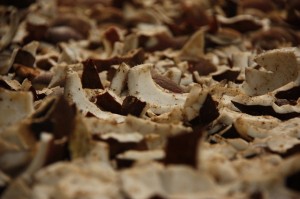 The major source of income is ‘Copra’. Copra is the dried coconut meat that is used for making palm oil. 90% of the production is exported to France, which is paying (again through major subsidies) 4 times the market price for the raw material. You see that without French support, life on these islands would be completely different and a lot harder. And still some people out there think they would be better off if they were independent from France…
The major source of income is ‘Copra’. Copra is the dried coconut meat that is used for making palm oil. 90% of the production is exported to France, which is paying (again through major subsidies) 4 times the market price for the raw material. You see that without French support, life on these islands would be completely different and a lot harder. And still some people out there think they would be better off if they were independent from France…
Day three in the Marquesas brought us to the Island of Hiva Oa. The island where both Paul Gauguin and Jacques Brel spent their last years and are buried. As a Belgian, visiting Hiva Oa is a special thing and it was one of the main reasons for me to come to the Marquesas. For those of you who don’t know Brel, he was one of the most important French language artists ever. 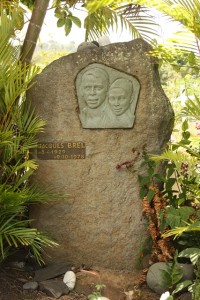 The French guide on the ship introduced him to the Anglo Saxon passengers by stating that he was “as important as Edith Piaf for French music”. He could also have illustrated his importance by quoting some of the world most important artists who have covered (translated) songs of Brel: David Bowie, Frank Sinatra, Ray Charles and… Nirvana! I only got to know his music in my late teens after a Belgian hip hop crew (Starflam) stated that he was one of their main inspirations. While I was preparing for his trip, I found out a lot more about his life and his time in the Marquesas. In the mid 1970’s Brel learned he had lung cancer and he wanted to live the rest of his life away from all the hype and attention. He started a sailing trip around the world which brought him to the island of Hiva Oa. Story goes that upon his arrival he went to the post office to check if there was mail for him and the clerk told him: “Jacques Brel…never heard of”. Right there he knew this was the place he had to stop and spent his last years. Unlike Gauguin whose escapades with many local girls earned him a dubious reputation, Brel is still held in good memory by a lot of inhabitants of Hiva Oa. To help out the isolated inhabitants Brel bought a small airplane (Jojo) which he used to collect mail, for medical evacuations and to shuttle students to their schools and back. He also created the first movie theatre and participated in a lot of campaigns to give the local youth a better future. He even had plans to start an airline company (Air Marquises) when in 1978 an emergency evacuation brought him to France where he died shortly after. His last wish was to be buried in Hiva Oa in the Calvary cemetery. We visited his grave that can be found next to Gauguin with the cross with Jezus in between the two. Just like the two criminals next to Jesus in the Biblical Calvary hill. There is also a small Brel museum with the restored airplane Jojo and a lot of info on his life in the Marquesas and his music playing on the sound system. Interesting to know is that the airplane before its restoration was used for decades for exercises by the Tahitian firemen. After restoration it was transported back to Hiva Oa by the Aranui ship that we were sailing.
The French guide on the ship introduced him to the Anglo Saxon passengers by stating that he was “as important as Edith Piaf for French music”. He could also have illustrated his importance by quoting some of the world most important artists who have covered (translated) songs of Brel: David Bowie, Frank Sinatra, Ray Charles and… Nirvana! I only got to know his music in my late teens after a Belgian hip hop crew (Starflam) stated that he was one of their main inspirations. While I was preparing for his trip, I found out a lot more about his life and his time in the Marquesas. In the mid 1970’s Brel learned he had lung cancer and he wanted to live the rest of his life away from all the hype and attention. He started a sailing trip around the world which brought him to the island of Hiva Oa. Story goes that upon his arrival he went to the post office to check if there was mail for him and the clerk told him: “Jacques Brel…never heard of”. Right there he knew this was the place he had to stop and spent his last years. Unlike Gauguin whose escapades with many local girls earned him a dubious reputation, Brel is still held in good memory by a lot of inhabitants of Hiva Oa. To help out the isolated inhabitants Brel bought a small airplane (Jojo) which he used to collect mail, for medical evacuations and to shuttle students to their schools and back. He also created the first movie theatre and participated in a lot of campaigns to give the local youth a better future. He even had plans to start an airline company (Air Marquises) when in 1978 an emergency evacuation brought him to France where he died shortly after. His last wish was to be buried in Hiva Oa in the Calvary cemetery. We visited his grave that can be found next to Gauguin with the cross with Jezus in between the two. Just like the two criminals next to Jesus in the Biblical Calvary hill. There is also a small Brel museum with the restored airplane Jojo and a lot of info on his life in the Marquesas and his music playing on the sound system. Interesting to know is that the airplane before its restoration was used for decades for exercises by the Tahitian firemen. After restoration it was transported back to Hiva Oa by the Aranui ship that we were sailing.
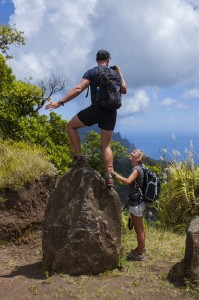 The next day was Fatu Hiva, the most remote and wildest of all islands which still has its rough edge. Here only half a century ago the anthropologist Thor Heyerdal had to flee into the bush to escape from a mob of locals that were ready to lynch him after he had been digging up and taking away some sacred items and bones. For us the programme of the day stated that “really athletic passengers can make a 16 km hike across the island” between the two sites where the ship would be docked that day. Feeling really ‘athletic’ we of course signed up. Actually it was a very scenic but not so difficult hike. The hardest things were the heat and the sun and the digestion of the gigantic lunch buffet that had been prepared half way the trek. The evening was spent in the ‘Bay des Vierges’. Originally it was called ‘Bay des Verges’ (Bay of penises) because of the phallus shaped peaks but the missionaries of course didn’t like this so they added an ‘I’ and it became ‘Bay des Vierges’ (Bay of Virgins).
The next day was Fatu Hiva, the most remote and wildest of all islands which still has its rough edge. Here only half a century ago the anthropologist Thor Heyerdal had to flee into the bush to escape from a mob of locals that were ready to lynch him after he had been digging up and taking away some sacred items and bones. For us the programme of the day stated that “really athletic passengers can make a 16 km hike across the island” between the two sites where the ship would be docked that day. Feeling really ‘athletic’ we of course signed up. Actually it was a very scenic but not so difficult hike. The hardest things were the heat and the sun and the digestion of the gigantic lunch buffet that had been prepared half way the trek. The evening was spent in the ‘Bay des Vierges’. Originally it was called ‘Bay des Verges’ (Bay of penises) because of the phallus shaped peaks but the missionaries of course didn’t like this so they added an ‘I’ and it became ‘Bay des Vierges’ (Bay of Virgins).
After Fatu Hiva the next days were spent at the islands of Tahuata where we spent the afternoon on one of the beaches where James Cook had landed on his second Pacific voyage and on Ua Huku the island of the woodcarvers. At the latter after a week of visiting local artists and ‘art markets’ we decided to deviate from our ‘no souvenirs’ policy and invested in some woodcarving, hoping we will be able to get it through customs in New Zealand and Australia.
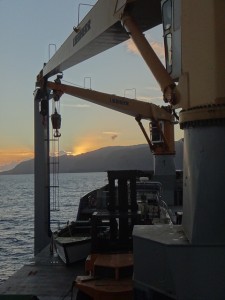 We spent two more days on the Islands of Nuku Hiva and Ua Poa where the ship picked up the containers that had been dropped there on the first passage and then it was time say goodbye to the Marquesas. On our way back we spent another morning on one of the islands of the Tuamotu islands group: Rangiroa where we went for a dive in the Tiputa pass. These short visits to the Tuamotu islands on our way to and from the Marquesas were a real nice bonus and made us want to come back to explore them a bit more.
We spent two more days on the Islands of Nuku Hiva and Ua Poa where the ship picked up the containers that had been dropped there on the first passage and then it was time say goodbye to the Marquesas. On our way back we spent another morning on one of the islands of the Tuamotu islands group: Rangiroa where we went for a dive in the Tiputa pass. These short visits to the Tuamotu islands on our way to and from the Marquesas were a real nice bonus and made us want to come back to explore them a bit more.
Because our trip marked the 10th anniversary of the Aranui 3 ship an exceptional deviation was made and we spent the last day on Bora Bora, where our travels in French Polynesia had started. It was great to see how the whole crew was really excited by this special trip. Nearly all of them were on deck taking pictures when the island came in sight. All though it’s only 30 minutes flying from Tahiti where they live, most of them had never visited the island.
Back on the main island of Tahiti we immediately hopped on a ferry to the neighbour island of Mo’orea where we spent the Easter weekend diving (we finally got to see some really big (Lemon) sharks) and cycling around the island.
Through spending a full month on the islands, we had hoped to be able to tick off the box for French Polynesia but instead we just discovered that there is so much more to see (Tuamotu and Austral islands) than we had time for, so once again we will need to come back some day to explore further.
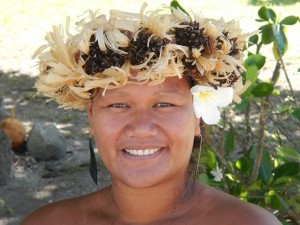 Visiting French Polynesia in March had been a serious gamble because the wet season lasts until late April and from travellers that were here in January and February we had heard that it had been raining almost non-stop for 3 months. However in the beginning of March the weather changed dramatically and for the whole month we saw hardly any rain (maybe three short showers) and the sun was blazing the whole time. Actually (and I know this will sound cruel to the people in Europe that have been freezing for months) we look forward to some cooler climates after all the heat (between 30 and 35 degrees every day) of the last couple of weeks. Next up is New Zealand where autumn has arrived so that should cool us down a bit.
Visiting French Polynesia in March had been a serious gamble because the wet season lasts until late April and from travellers that were here in January and February we had heard that it had been raining almost non-stop for 3 months. However in the beginning of March the weather changed dramatically and for the whole month we saw hardly any rain (maybe three short showers) and the sun was blazing the whole time. Actually (and I know this will sound cruel to the people in Europe that have been freezing for months) we look forward to some cooler climates after all the heat (between 30 and 35 degrees every day) of the last couple of weeks. Next up is New Zealand where autumn has arrived so that should cool us down a bit.
[ad-gallery orderby=”menu_order” width=”550px” height=”300px” imagedesc=”none”]

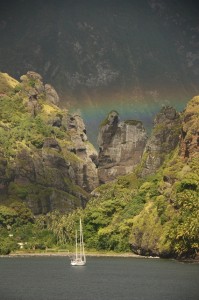
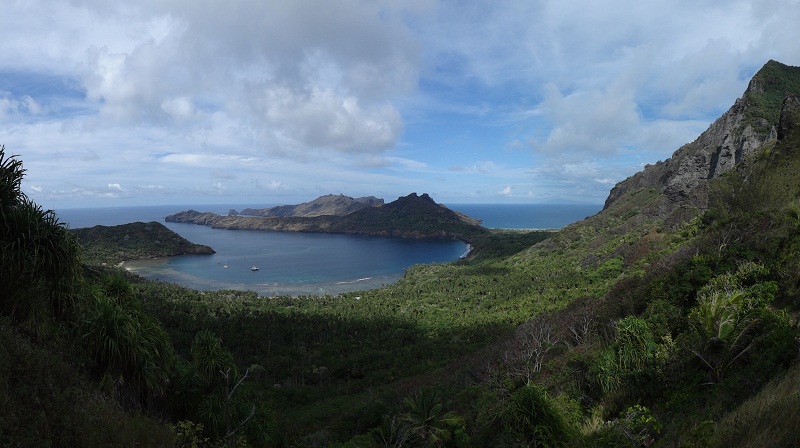
sjonge jonge… het blijft adembenemd!! 🙂
Mooie T-shirt van de ‘Gensche Fieste’ 🙂
Ik lees nog steeds met veel plezier uw berichten. Hou je goed.
De thuistad een beetje vertegenwoordigen hé… Ik krijg er trouwens behoorlijk veel commentaar op. Het doet me plezier te zien dat jullie nog volgen (ik zie veel ‘traffic’ naar de site van op de Teku Kan pagina).
Overduidelijk…. we kunnen Jaques Brel geen ongelijk geven!
Dikke knuffel
mamaroos
So many great photos and so many memories, you’ll be very difficult to come back among us … to work ;o))